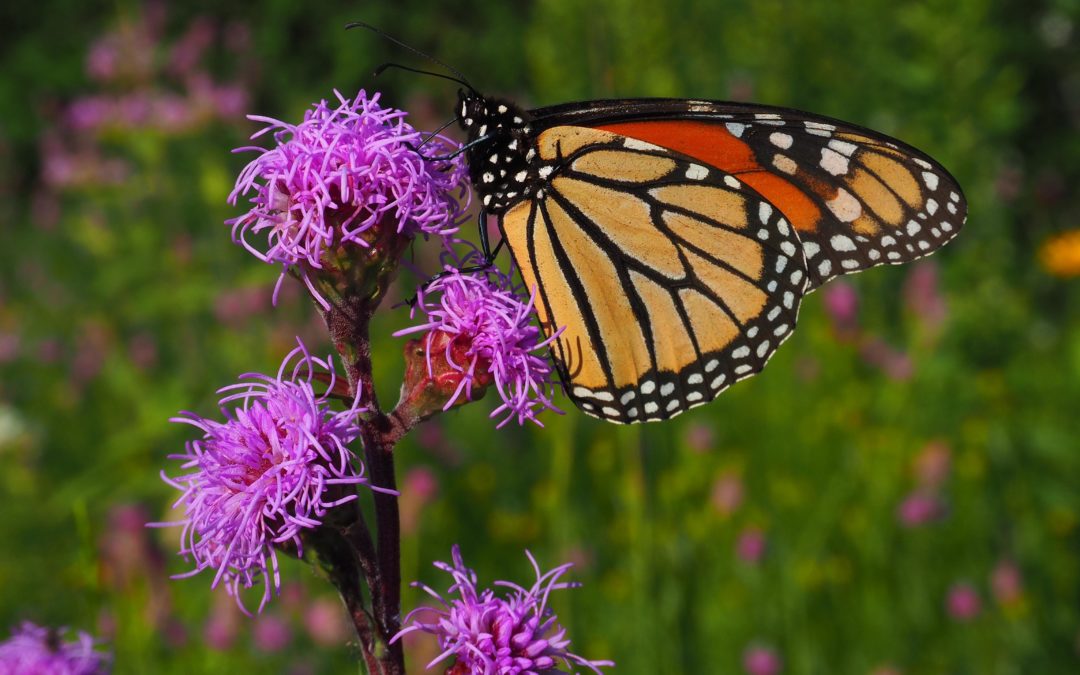Pollinator Powerhouses: A Look at Our Top 5 Native Herbaceous Plant Species that Support Pollinators in the Upper Midwest
Bees, butterflies, birds oh my! Not only are these types of pollinators simply a joy to observe, but they also play a critical role in supporting our native ecosystems. As they interact with plant communities in search of food and habitat, they transport pollen that is essential to plant fertilization and reproduction. Pollinators are the vessel that ensures the next generation of midwest wildflowers and grasses – and they look great doing it.
Pollinators serve as a key link in our complex food systems, as well as an aesthetic charm that brightens up our lives and landscapes. Recently, many of our vital pollinator species have faced pressure as a result of habitat loss, climate change, disease and pesticide use. Even the most iconic of pollinator species, such as the Monarch Butterfly and the Rusty-Patched Bumblebee, have been negatively impacted by these forces. One way to support those pollinator species at risk is to promote the use of native plants into your landscape.
While many native plants can help support pollinators, there are a few groups or families of plants that stand above the rest. Listed below are our Top 5 Pollinator Plant Groups;
Milkweeds
Examples: Common Milkweed (Asclepias syriaca), Butterfly Weed (Asclepias tuberosa), Swamp Milkweed (Asclepias incarnata), Whorled Milkweed (Asclepias verticillata), etc. Bloom Time(s): June – September Bloom Color(s): Pink, Purple, White, Orange depending on species. Pollinators Supported: Monarch Butterflies (Caterpillars), Bumblebees, Eastern Tiger Swallowtail. Notes: Not all milkweed species are native to the Midwest, please be cautious and verify origin when purchasing from commercial nurseries.
Joe-Pye Weed, etc
Examples: Spotted Joe-Pye Weed (Eutrochium maculatum), Sweet Scented Joe-Pye Weed (Eutrochium purpureum), Common Boneset (Eupatorium perfoliatum), etc. Bloom Time(s): July – October Bloom Color(s): Purple, Pink, White. Pollinators Supported: Ruby Tiger Moth, Rusty Patched Bumble Bee, Azures, Skippers. Notes: A gardener favorite, these species stand tall and spread quickly. Generally preferring moist soils, you can find both sun and shade loving species in this group.
Blazing Stars
Examples: Prairie Blazing Star (Liatris pycnostachya), Meadow Blazing Star (Liatris ligulistylis), Rough Blazing Star (Liatris aspera), etc. Bloom Time(s): July – September Bloom Color(s): Purple, Pink. Pollinators Supported: Hummingbirds, Monarchs, Painted Lady Butterflies, Honeybees, Carpenter bees, Miner bees, and Leaf-Cutting bees. Notes: There are five (5) species of Blazing Star native to Minnesota, all of which offer a food source for pollinators. The Meadow Blazing Star has even earned the nickname, “The Monarch Magnet”, as Monarch Butterflies can be seen swarming this species to feed on its nectar.
Bee Balms
Examples: Wild Bergamot (Monarda fistulosa), Spotted Beebalm (Monarda punctata), etc. Bloom Time(s): June – September Bloom Color(s): Purple, Pink, White Pollinators Supported: Raspberry Pyrausta Butterfly (Host), Karner Blue Butterfly, Bumblebees. Notes: A staple of the prairie, species in the Monarda family are versatile and provide services to pollinators and humans alike. Its aroma and medicinal properties are a nice addition to any home garden or native landscape, and pollinators will love it too.
Goldenrods
Examples: Stiff Goldenrod (Solidago rigida), Gray Goldenrod (Solidago nemoralis), Showy Goldenrod (Solidago speciosa), Zigzag Goldenrod (Solidago flexicaulis), etc. Bloom Time(s): July – October Bloom Color(s): Yellow. Pollinators Supported: Monarch Butterflies as well as a variety of bees, native flies, beetles and songbirds. Notes: Goldenrods are a mis-judged species that provide an excellent, late-season food source for pollinators.
The fall blooms provide a nice splash of color to mark the end of the growing season. One particular native species, Canada Goldenrod (Solidago canadensis), spreads aggressively and often requires management to limit its spread. The power of native plants is unparalleled; they provide an array of benefits including habitat and food for pollinators. By adding these families/species of native plants, you can turn your next planting into a pollinator haven.
Resources:
https://www.minnesotawildflowers.info/
https://www.dnr.state.mn.us/pollinators/index

Recent Comments